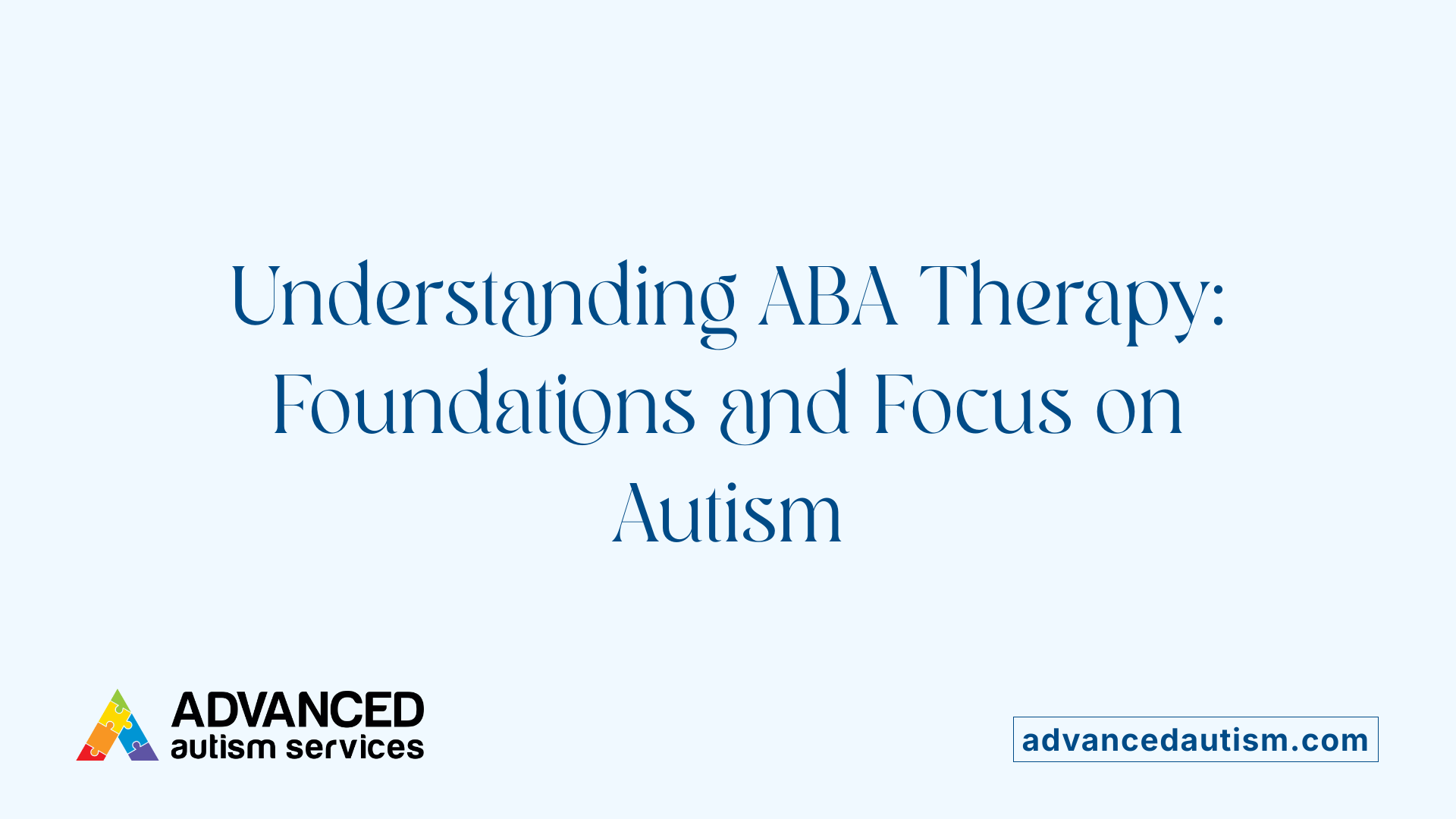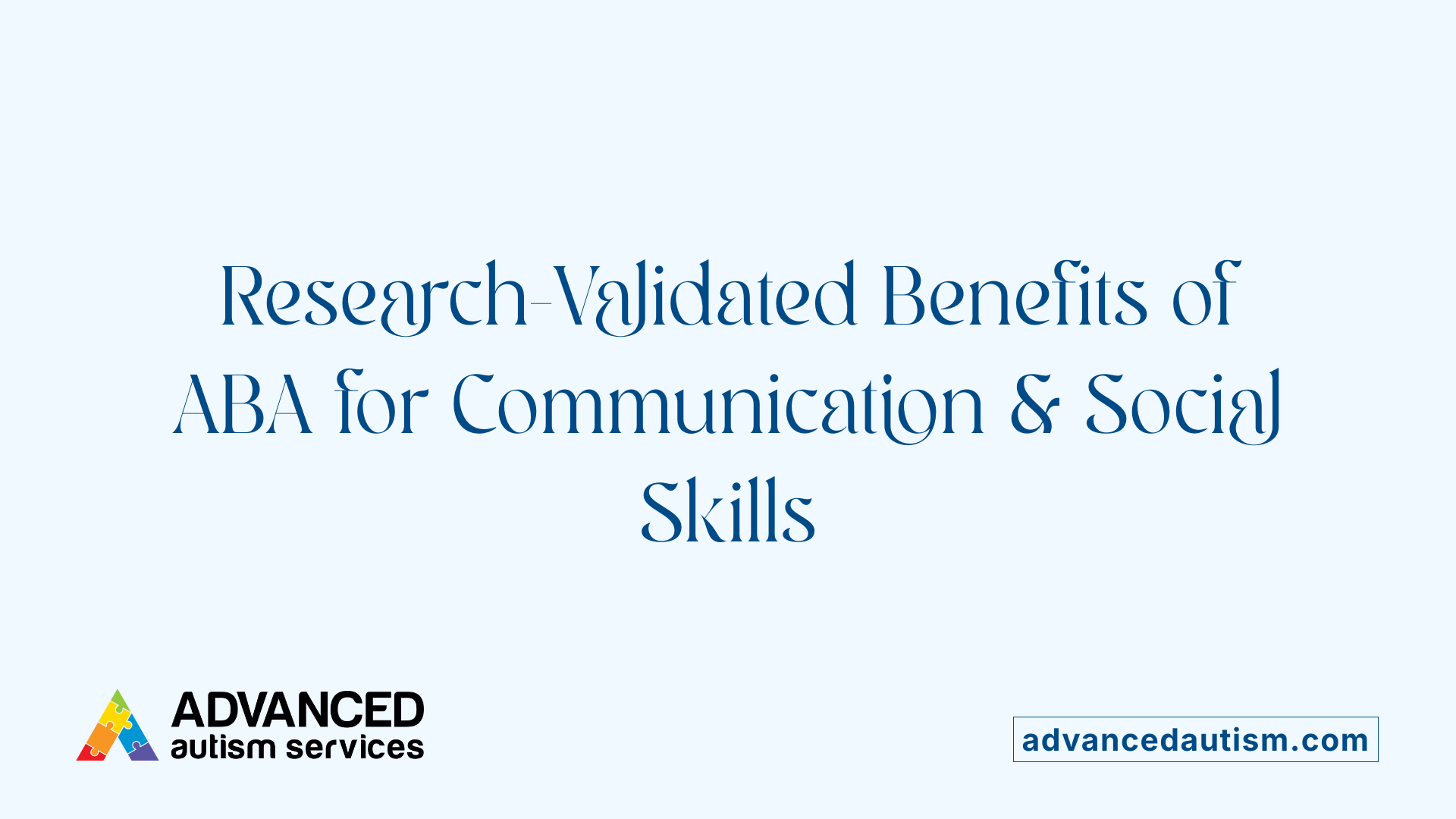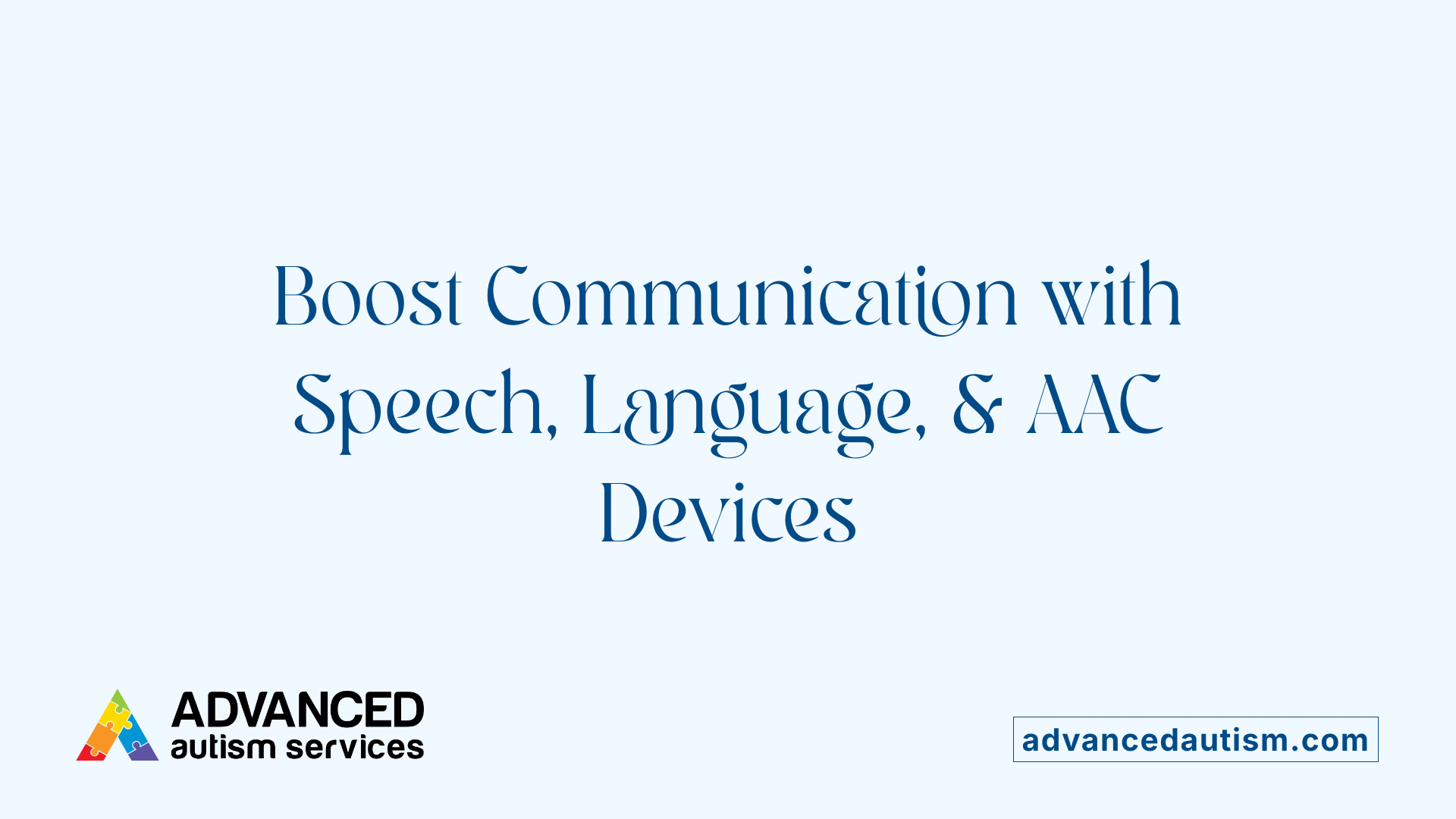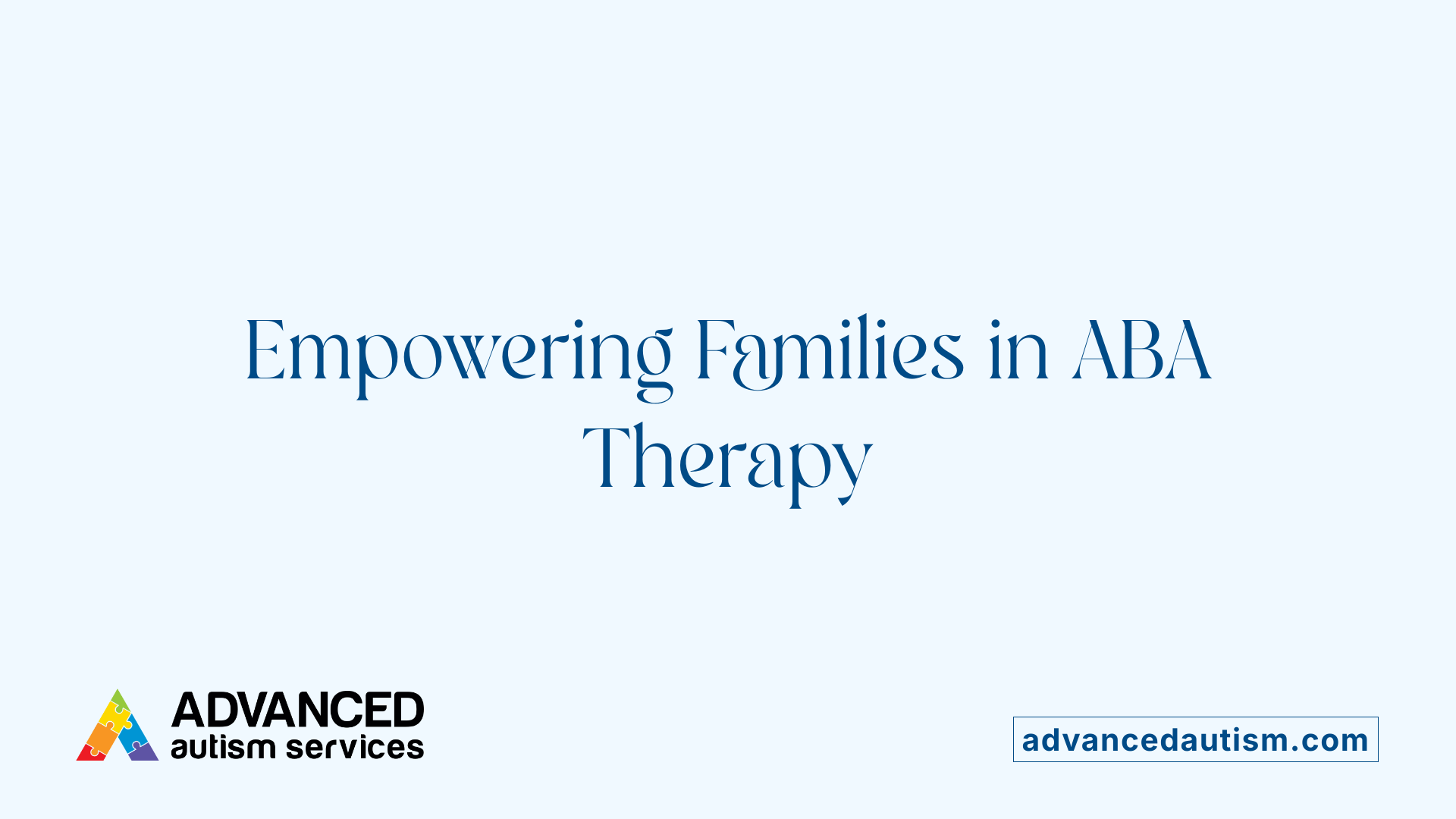ABA Therapy and Social Communication
Unlocking Social Potential: How ABA Therapy Enhances Communication in Autism
Understanding ABA Therapy’s Role in Social Communication
Applied Behavior Analysis (ABA) therapy stands as a cornerstone intervention for children with autism spectrum disorder (ASD), especially in fostering improved social and communication abilities. Grounded in the science of learning and behavior, ABA therapy strategically employs evidence-based methods to support individuals with autism in enhancing critical life skills, addressing problem behaviors, and achieving greater independence. This article explores how ABA therapy aids social communication, who provides it, and the techniques and evidence underpinning its success.
What Is ABA Therapy and Its Focus on Autism and Behavior Analysis?

Definition of ABA Therapy
Applied Behavior Analysis (ABA) is a therapy rooted in the science of learning and behavior. It focuses on understanding how behavior works and how environmental factors influence it. ABA seeks to increase helpful behaviors while reducing harmful or disruptive ones, primarily benefiting individuals with autism spectrum disorder (ASD).
Principles of Learning and Behavior
ABA uses well-established principles from behavioral science, including the concept that behavior is influenced by antecedents (what happens before a behavior) and consequences (what follows the behavior). This understanding helps therapists shape behavior in a meaningful way.
Behavioral Analysis with the ABC Model
A core technique in ABA is the ABC model: Antecedent, Behavior, Consequence. By analyzing what triggers a behavior and what consequences maintain it, therapists can design strategies to replace inappropriate behaviors with positive, functional ones.
Positive Reinforcement
Positive reinforcement is a fundamental principle of ABA therapy. Desirable behaviors are rewarded immediately to encourage their recurrence. This approach strengthens motivation and fosters sustained behavior change.
Individualized Programs for Autism
ABA programs are tailored to each individual's unique skills, interests, needs, and family circumstances. These personalized plans are created and overseen by qualified Board-Certified Behavior Analysts (BCBAs) who monitor progress through ongoing data collection and assessments.
Effectiveness and Goals of ABA Therapy
Evidence from multiple studies supports ABA's effectiveness in improving communication, social skills, academic performance, and daily living abilities. Intensive, long-term ABA interventions aim to foster independence and functional success in individuals with autism by breaking developmental goals into manageable steps and involving families in the therapeutic process.
Table summarizing ABA elements:
| Aspect | Description | Purpose |
|---|---|---|
| ABC Model | Antecedent-Behavior-Consequence framework | Understanding and modifying behaviors |
| Positive Reinforcement | Rewarding desirable behaviors | Encouraging behavior repetition |
| Individualization | Tailoring programs to the person | Meeting specific needs and fostering success |
| Professional Oversight | Programs designed and supervised by BCBAs | Ensuring effective, ethical treatment |
| Evidence Base | Supported by research over decades | Validating therapy effectiveness |
Who Provides ABA Therapy? Professional Roles and Qualifications

Who Typically Provides Autism and Behavioral Analysis Therapy?
Applied Behavior Analysis (ABA) therapy is delivered by a dedicated team of professionals with specialized training. The primary providers include Board Certified Behavior Analysts (BCBAs), behavior therapists, and behavior technicians such as Registered Behavior Technicians (RBTs) and Assistant Behavior Analysts Technicians (ABATs).
Role of Board Certified Behavior Analysts (BCBAs)
BCBAs are highly trained professionals who oversee the design, implementation, and evaluation of ABA programs. They conduct detailed assessments, develop individualized treatment plans, and monitor progress, ensuring that therapy goals align with each client's unique needs and family circumstances.
Behavior Therapists and Behavior Technicians
Behavior therapists and technicians provide direct one-on-one therapy sessions using techniques like positive reinforcement and discrete trial training under BCBA supervision. These practitioners are essential in delivering day-to-day interventions and maintaining a safe, supportive environment for clients.
Settings Where ABA is Delivered
ABA therapy occurs in diverse settings such as homes, schools, clinics, and community environments. This flexibility allows programs to be tailored and generalized across real-life situations, promoting independence and skill transfer.
Training and Certification Requirements
Providers typically undergo rigorous training and certification processes, including passing credentialing exams like the BCBA or RBT certifications. Ongoing education and supervision maintain high-quality practice standards and ensure adherence to ethical guidelines.
Importance of Supervision and Family Involvement
BCBAs closely supervise therapy delivery to ensure safety and effectiveness. Family involvement is also integral, as training parents and caregivers helps generalize skills to natural environments and supports long-term success.
This collaborative, qualified team approach ensures ABA therapy is delivered effectively, ethically, and person-centered, fostering meaningful progress for individuals with autism.
Core Techniques in ABA Therapy Supporting Social Communication

What are the core techniques used in ABA therapy to support social and communication skills?
Applied Behavior Analysis (ABA) therapy employs a variety of well-established techniques designed to improve social and communication skills in individuals, particularly those with autism spectrum disorder (ASD). These methods are centered around behavior analysis principles and are tailored to each individual's needs.
One fundamental technique is positive reinforcement, which rewards desirable behaviors to encourage their repetition. By consistently reinforcing appropriate social interactions or communication attempts, therapists promote meaningful and lasting behavior change.
The ABC behavioral model—Antecedent, Behavior, Consequence—is another central concept. This approach helps analyze the triggers (antecedents) and outcomes (consequences) of behaviors, allowing therapists to modify the environment and responses to encourage positive social communication while reducing undesired behaviors.
Discrete Trial Training (DTT) breaks down social and communication skills into small, manageable components that are taught step-by-step through repeated trials and reinforcement. This structured method helps learners acquire targeted skills efficiently.
Modeling techniques involve therapists demonstrating the desired social or communication behaviors. Learners observe and imitate these behaviors, which supports skill acquisition in areas such as conversation and socially appropriate responses.
The Picture Exchange Communication System (PECS) aids individuals with speech delays or difficulties by teaching them to communicate using pictures. PECS enables non-verbal learners to express needs and engage socially, fostering stronger communication skills.
Functional Communication Training (FCT) replaces challenging behaviors like crying or screaming with effective communication methods, such as speech, gestures, or AAC devices. This approach is crucial for developing meaningful functional communication.
Finally, Natural Environment Training (NET) promotes social communication by teaching skills within natural settings and daily routines. This technique encourages generalization of learned behaviors into real-life situations, increasing independence and social competence.
Together, these ABA techniques provide a comprehensive framework that enhances social communication abilities, supports meaningful interactions, and fosters growth tailored to the individual’s unique abilities and environments.
Targeting Social Skill Deficits through ABA Interventions

Improving turn-taking and social initiation
ABA therapy helps children with autism develop essential social interaction skills such as turn-taking and social initiation. Therapists use structured sessions to teach these skills by reinforcing positive social behaviors and encouraging children to initiate interactions with peers and adults.
Teaching emotion recognition and empathy
A vital component of ABA is teaching children to recognize emotions and develop empathy. Techniques include modeling emotions, using visual aids, and engaging children in exercises that highlight different feelings and appropriate responses.
Role-playing and social stories
ABA incorporates role-playing and social stories to simulate social scenarios, allowing children to practice responses in a safe and supportive environment. These strategies help prepare them for real-world interactions by breaking down social situations into understandable parts.
Understanding social cues such as body language and facial expressions
Children learn to interpret important non-verbal signals like body language and facial expressions through targeted ABA strategies. This skill helps improve their ability to respond appropriately in social settings.
Enhancing conflict resolution skills
ABA interventions teach children constructive ways to handle conflicts. Through guided role-play and reinforcement plans, children develop skills for negotiating disagreements and managing emotions during challenging social situations.
These interventions are tailored to each child's unique needs and involve parents and caregivers to promote generalization of skills across settings. This comprehensive approach has been shown to significantly improve social understanding and adaptive behaviors in children with autism.
The Importance of Individualized ABA Programs and Ongoing Assessment

Personalized treatment plans
ABA therapy is highly individualized, designed to meet the unique needs, skills, interests, and family circumstances of each person. This tailored approach ensures that interventions are relevant and effective for the individual's specific challenges and strengths.
Functional Skill Assessments (FSAs)
Functional Skill Assessments are crucial in identifying the areas where a learner requires support. FSAs focus on daily living skills, self-care, communication, and social functioning, guiding the development of targeted goals for each ABA program.
Breaking down developmental goals
ABA therapy breaks down complex developmental objectives into smaller, manageable steps. This methodical approach allows learners to practice and master incremental behaviors, promoting meaningful and sustained progress.
Data collection and progress monitoring
Ongoing data collection is a foundation of ABA practice. Therapists continuously track progress toward goals, using this information to refine interventions. Regular review of data ensures that therapy remains responsive and effective.
Collaboration with families and caregivers
Success in ABA therapy strongly depends on involving families and caregivers. Training and support are provided to help generalize skills outside of therapy sessions and integrate strategies into everyday routines.
Program adjustments based on individual response
Based on collected data and collaboration feedback, ABA programs are consistently adjusted to better fit the learner's evolving needs. This flexible, responsive treatment model maximizes the individual's development and fosters independence.
Evidence Supporting ABA Therapy’s Impact on Communication and Social Behavior

Research studies and statistical significance
Multiple research studies have demonstrated the effectiveness of Applied Behavior Analysis (ABA) therapy in improving social and communication skills in children with autism. For example, a study involving an experimental group receiving ABA training twice a week over six weeks showed significant improvements in social and emotional skills. These improvements were statistically validated with p-values less than 0.05, confirming the reliability of the results.
Long-term and intensive treatment effectiveness
Evidence from over 20 studies highlights that intensive and long-term ABA therapy—typically 25 to 40 hours per week for 1 to 3 years—produces significant gains. These gains include improvements not only in communication and social interaction but also in cognitive skills and daily living abilities, supporting ABA as an effective intervention over sustained periods.
Improvements in language, social functioning, and daily living
ABA interventions lead to notable advancements in language development, social functioning, memory, attention, and overall daily living skills. Children undergoing ABA show better adaptive behaviors and enhanced communication abilities, which contribute to increased independence and quality of life.
Use of validated measurement tools like KIST
Validated assessment tools such as the Kindergarten Inventory of Social/Emotional Tendencies (KIST) are employed to measure social and emotional development objectively. Utilizing such tools enables therapists to quantify progress accurately and tailor interventions to individual needs.
Outcomes such as reduced separation anxiety and improved adaptive behaviors
Beyond social skills and communication, ABA therapy has been shown to reduce problem behaviors including separation anxiety and improve adaptive behaviors necessary for everyday functioning. These outcomes highlight ABA’s comprehensive approach to fostering emotional regulation and functional independence in children with autism.
Enhancing Communication Skills: Speech, Language, and AAC Devices

Speech and language development improvements
ABA therapy plays a significant role in fostering speech and language development, particularly in children with autism spectrum disorder (ASD). Through individualized programs, therapists work on breaking down language goals into smaller, manageable steps. This stepwise approach, combined with positive reinforcement, encourages children to communicate more effectively and enhances their verbal abilities.
Use of augmentative and alternative communication (AAC) devices
For children with speech delays or difficulties, ABA therapy incorporates the use of augmentative and alternative communication (AAC) devices. These include tools like the Picture Exchange Communication System (PECS), which supports communication by enabling children to express needs and desires through pictures. Using AAC devices helps bridge communication gaps and promotes interaction when verbal speech is limited.
Teaching non-verbal communication cues and pragmatic language
ABA therapists also prioritize teaching non-verbal communication skills, such as recognizing and using facial expressions, body language, and gestures. This training improves pragmatic language — the social aspects of communication — allowing children to better interpret and respond to social cues, fostering more meaningful interactions with peers and family.
Approaches to functional communication
Functional Communication Training (FCT), a key component of ABA, targets replacing problematic behaviors like crying or screaming with appropriate communication methods. Using speech, gestures, or AAC devices, children learn effective ways to express needs and emotions, which reduces frustration and improves social engagement.
Supporting children with speech delays
ABA therapy supports children with speech delays through modeling, role-playing, and reinforcing communication efforts. Therapists demonstrate desired language behaviors and support children as they practice in natural settings. Parental involvement ensures these skills generalize to the home environment, providing consistency and encouraging progress.
| Focus Area | ABA Technique Used | Description |
|---|---|---|
| Speech and language development | Stepwise goal breakdown, reinforcement | Improves verbal skills through systematic teaching and rewards |
| AAC devices | PECS, Picture Exchange Communication System | Provides non-verbal communication options for speech delays |
| Non-verbal and pragmatic language | Teaching facial expressions, body language | Enhances understanding and use of social communication cues |
| Functional communication | Functional Communication Training (FCT) | Replaces problematic behaviors with effective communication |
| Speech delay support | Modeling, role-playing, parental involvement | Encourages consistent language practice and generalization |
Parental and Caregiver Involvement in Successful ABA Therapy

Training Parents and Caregivers
A crucial aspect of Applied Behavior Analysis (ABA) therapy's success lies in training parents and caregivers. They are taught techniques that reinforce positive behaviors and manage challenging ones, ensuring consistent support outside therapy sessions. This training empowers families to become active participants in the learning process.
Generalization of Learned Skills to the Home Environment
For ABA therapy to be truly effective, skills acquired during sessions must transfer to everyday settings. Families help generalize these behaviors from clinics or schools to the home, making the intervention practical and sustainable. This includes coaching children on communication and social skills amid real-life scenarios.
Importance of Family Input in Therapy
Family involvement is fundamental in customizing ABA programs. Parents and caregivers provide valuable insights about the child's interests, needs, and preferences. Their feedback is integrated into treatment planning and ongoing adjustments, reinforcing therapy goals that align with everyday life.
Strategies for Supporting Ongoing Communication and Social Skills
To maintain progress, strategies such as role-playing, use of social stories, and modeling socio-communicative behaviors are encouraged at home. This continuous practice helps children recognize social cues, express themselves effectively, and build positive interactions beyond formal sessions.
Building Collaborative Relationships with Therapy Providers
Effective ABA therapy depends on strong collaboration between families and professionals. Open communication ensures that therapeutic approaches reflect the child’s evolving needs. Regular progress reviews, goal setting, and coordinated efforts between therapists and caregivers foster an environment conducive to growth and independence.
Addressing Behavioral Challenges through ABA: From Problem Behaviors to Functional Communication

Understanding Function of Behaviors
ABA therapy begins by identifying the specific reasons behind a behavior. Using the ABC model—Antecedent, Behavior, Consequence—therapists analyze what triggers actions and what outcomes maintain them. Understanding these functions is essential for guiding effective interventions and for teaching alternative, positive behaviors.
Replacing Problematic Behaviors with Communication Skills
A central goal of ABA is to substitute challenging behaviors like crying or screaming with appropriate communication methods. Functional Communication Training (FCT) is used to teach children to express their needs through speech, gestures, or augmentative communication devices. This skill replacement reduces frustration and enhances social participation.
Benefits of Functional Communication Training (FCT)
FCT promotes meaningful communication, leading to fewer disruptive behaviors. It empowers children to request help, express feelings, and engage socially. By addressing the root cause of problem behaviors, FCT fosters longer-lasting improvements in behavior and emotional well-being.
Improving Emotional Regulation and Reducing Problem Behaviors
ABA also targets emotional regulation by teaching strategies to recognize and manage emotions. This helps reduce behaviors driven by anxiety, frustration, or overstimulation. Structured teaching methods improve a child’s ability to cope with stress and adapt to changes.
Creating Positive Behavior Change with Reinforcement
Positive reinforcement is a foundational technique in ABA. Desired behaviors are rewarded immediately to encourage repetition and build new skills. This method makes learning enjoyable and motivates children to engage in adaptive behaviors, improving their overall functioning and quality of life.
Navigating Insurance, Cost, and Access to ABA Therapy

What Are the Cost Factors and Hourly Rates for ABA Therapy?
ABA therapy costs vary widely depending on the specific needs of the individual, the type of program, and the experience of the provider. On average, hourly rates for ABA therapy are around $120. Factors influencing cost include the intensity of therapy required, the qualifications of therapists, the range of services offered, and geographical location. Programs that require intensive hours and specialized interventions typically incur higher expenses.
How Does Insurance Coverage Work for ABA Therapy?
Many private health insurance plans are now required to cover ABA therapy when deemed medically necessary. Medicaid also provides coverage for children under the age of 21 in many states. However, insurance policies differ in the extent and conditions of coverage. It is crucial for families to verify individual policy details and understand what services and durations are covered.
Are There State-Specific Variations in Coverage?
Coverage for ABA therapy differs significantly by state. Some states have comprehensive mandates requiring insurers to cover ABA services, while others offer limited or no mandates. Additionally, some states provide grants and other financial support programs for families seeking ABA therapy. Awareness of state regulations can help families access available financial assistance.
What Strategies Can Families Use to Verify and Secure Funding?
Families should thoroughly review insurance policies, contact insurers directly for clarification, and request documentation on covered ABA services. Engaging with healthcare providers and social workers can assist in navigating insurance claims and appeals. It's advisable to keep detailed records of therapy plans and progress to support claims. Seeking assistance from advocacy groups can also be beneficial.
How to Choose Qualified Providers and Evaluate Therapy Approaches?
Selecting the right ABA provider involves assessing qualifications, training, and supervision of behavior analysts and therapists. Families should inquire about the provider's approach to goal setting, progress tracking, and safety protocols. Personalization of therapy to meet individual needs, along with family involvement, is essential for success. Checking provider credentials such as Board Certified Behavior Analysts (BCBAs) ensures professional standards are met.
The Future of Social Communication Enhancement Through ABA Therapy
Applied Behavior Analysis therapy remains a scientifically validated, individualized approach that significantly improves social communication and behavioral skills in individuals with autism. Through structured techniques, family collaboration, and ongoing assessment, ABA supports children and adults in achieving greater independence and quality of life. Despite challenges like access and cost, growing evidence and insurance support continue to expand availability. As research advances and therapy methodologies evolve, ABA therapy is poised to remain essential in unlocking the social potential and communication abilities of those on the autism spectrum.
References
- Applied Behavior Analysis (ABA)
- The effectiveness of applied behavior analysis program ...
- The Power of Progress: Applied Behavior Analysis (ABA) ...
- Beyond Behavior: ABA Therapy's Impact on Social and ...
- Applied Behavioral Analysis: Overview, Techniques & Cost
- ABA Clinics/Behavior Specialist for Toddlers in Los Angeles
- Behavioral Health Treatment | Children with Autism Spectrum ...
- Applied Behavior Analysis (ABA)
- California ABA Therapy - Autism Therapy & Services







